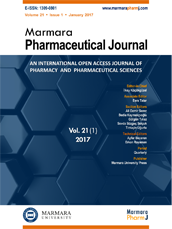Editor-in-Chief
Hatice Kübra Elçioğlu
Vice Editors
Levent Kabasakal
Esra Tatar
Online ISSN
2630-6344
Publisher
Marmara University
Frequency
Bimonthly (Six issues / year)
Abbreviation
J.Res.Pharm.
Former Name
Marmara Pharmaceutical Journal
Marmara Pharmaceutical Journal
2018 , Vol 22 , Issue 1
Comparatively investigation of grape molasses produced by conventional and industrial techniques
1Yeditepe University, Faculty of Pharmacy, Department of Toxicology, 34755, Atasehir, İstanbul, Turkey2Yeditepe University, Faculty of Pharmacy, Department of Pharmacognosy, 34755, Atasehir, İstanbul, Turkey
3Yeditepe University, Faculty of Pharmacy, Department of Analytical Chemistry, 34755, Ataşehir, İstanbul, Turkey DOI : 10.12991/mpj.2018.39 In the present study, phenolic compounds compositions, antioxidant potentials and trace element contents of grape molasses produced by traditional and industrial techniques were comparatively investigated. The phenolic components (gallic acid, catechin, epigallocatechin, quercetin etc.) were evaluated using a high-performance liquid chromatographic (HPLC) method and also their total phenol and flavonoid contents were determined. Antioxidant activity of the samples were investigated by using total antioxidant capacity (TOAC), cupric reducing capacity (CUPRAC) and hydrogen peroxide scavenging activity techniques. Additionally, dietary element contents of the molasses and molasses soil samples were determined by atomic absorption and X-ray fluorescence spectroscopy, respectively. Consequently, the concentration of phenolic compounds, total phenol contents and antioxidant activity in grape molasses produced by traditional techniques were found to be higher than that produced by industrial techniques. On the other hand, iron and copper levels in some traditionally produced samples were found to be above the limits established by the international and Turkish standards. In conclusion, production method can influence the content of grape molasses but the type of the grape, growing conditions, soil etc. should also be considered as a quality factor for the final product on market. Keywords : Vitis vinifera L., high-performance liquid chromatography (HPLC), total phenol content, antioxidant activity, dietary elements

